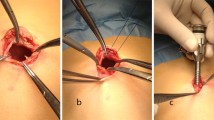Abstract
Purpose
To retrospectively analyze the feasibility, safety and complication rate of laparoscopic inguinal herniorraphy in babies weighing 5 kg or less.
Methods
Thirty infants weighing 5 kg or less underwent laparoscopic inguinal hernia repair during a 3-year period. Twenty-eight infants were born preterm and the mean body weight at surgery was 3,800 kg. Internal inguinal ring was closed with a non-absorbable purse-string suture. Contralateral processus vaginalis was closed if patent. Feeding was started on the same day and the patient discharged the following day. Follow-up consisted of physical examination at 1 week, 6 and 12 months post-operatively.
Results
Of the 30 patients (27 males, 3 females), 11 had bilateral and 19 monolateral hernia (16 right, 3 left). At laparoscopy, 23 infants needed to have bilateral herniorraphies. The mean corrected gestational age at surgery was 49.1 weeks. The mean operative time for repair was 30 min for unilateral and 41 min for bilateral hernia. There were not intra- or post-operative complications as well as conversions or recurrences.
Conclusions
Laparoscopic inguinal hernia repair in newborns and in ex-preterm infants is a safe and effective procedure to perform and, perhaps, even less technically demanding than open herniotomy.





Similar content being viewed by others
References
Grosfeld JL (1989) Current concepts in inguinal hernia in infants and children. World J Surg 13:506–515
Chan IHY, Lau CT, Chung PHY, Chan KL, Lan LCL, Wong KKY, Tam PKH (2013) Laparoscopic inguinal hernia repair in premature neonates: is it safe? Pediatr Surg Int 29:327–330
Turial S, Enders J, Krause K, Schier F (2010) Laparoscopic inguinal herniorraphy in premature infants. Eur J Pediatr Surg 20:371–374
Turial S, Enders J, Krause K, Schier F (2011) Laparoscopic inguinal herniorraphy in babies weighing 5 kg or less. Surg Endosc 25:72–78
Esposito C, Turial S, Escolino M, Giurin I, Alicchio F, Enders J, Krause K, Settimi A, Schier F (2012) Laparoscopic inguinal hernia repair in premature babies weighing 3 kg or less. Pediatr Surg Int 28:989–992
Shalaby R, Ibrahem R, Shahin M, Yehya A, Abdalrazek M, Alsayaad I, Shouker MA (2012) Laparoscopic hernia repair versus open herniotomy in children: a controlled randomized study. Minim Invasive Surg 2012:484135
Parelkar SV, Oak S, Gupta R, Sanghvi B, Shimoga PH, Kaltari D, Prakash A, Shekhar R, Gupta A, Bachani M (2010) Laparoscopic inguinal hernia repair in the pediatric age group-experience with 437 children. J Pediatr Surg 45:789–792
Perlstein J, Du Bois JJ (2000) The role of laparoscoy in the management of suspected recurrent paediatric hernias. J Pediatr Surg 35:1205–1208
Schier F, Montoupet P, Esposito C (2002) Laparoscopic inguinal herniorraphy in children: a three-center experience with 933 repairs. J Pediatr Surg 37:323–327
Ron O, Eaton S, Pierro A (2007) Systematic review of the risk of developing a metachronous contralateral inguinal hernia in children. Br J Surg 94:804–811
Choi W, Hall NJ, Garriboli M, Ron O, Curry JI, Cross K, Drake DP, Kiely EM, Eaton S, De Coppi P, Pierro A (2012) Outcomes following laparoscopic inguinal hernia repair in infants compared with older children. Pediatr Surg Int 28:1165–1169
Geisler DP, Jegathesan S, Parmley MC, McGee JM, Nolen MG, Broughan TA (2001) Laparoscopic exploration for the clinically undetected hernia in infancy and childhood. Am J Surg 182:693–696
Nagraj S, Sinha S, Grant H, Lakhoo K, Hitchcock R, Johnson P (2006) The incidence of complications following primary inguinal herniotomy in babies weighing 5 kg or less. Pediatr Surg Int 22:500–502
Miyano G, Yamataka A, Okada Y, Shimotakahara A, Kaneko K, Lane GJ, Yamashiro Y, Miyano T (2004) Sigmoidocolocystoplasty for augmentation of iatrogenic small capacity bladder caused by direct injury to the bladder durind inguinal hernia repair: long term follow up. Pediatr Surg Int 20:61–64
Phelps S, Agrawal M (1997) Morbidity after neonatal inguinal herniotomy. J Pediatr Surg 32:445–447
Rescorla FJ, Grosfeld JL (1984) Inguinal hernia repair in the perinatal period and early infancy: clinical considerations. J Pediatr Surg 19:832–837
Lautz TB, Raval MV, Reynolds M (2011) Does timing matter? a national perspective on the risk of incarceration in premature neonates with inguinal hernia. J Pediatr 158:573–577
Lee SL, Gleason JM, Sydorak RM (2011) A critical review of premature infants with inguinal hernias: optimal timing of repair, incarceration risk and postoperative apnea. J Pediatr Surg 46:217–220
Uemura S, Woodward AA, Amerena R, Drew J (1999) Early repair of inguinal hernia in premature babies. Pediatr Surg Int 15:36–39
Baird R, Gholoum S, Laberge JM, Puligandla P (2011) Prematurity, not age at operation or incarceration, impacts complication rates of inguinal hernia repair. J Pediatr Surg 46:908–911
Malvija S, Swartz J, Lerman J (1993) Are all preterm infants younger than 60 weeks postconceptual age at risk for post-anesthetic apnea? Anesthesiology 78:1076–1081
Cotè CJ, Zaslavsky A, Downes JJ, Kurth CD, Welborn LG, Warner LO, Malviya SV (1995) Postoperative apnea in former preterm infants after inguinal herniorraphy. a combined analysis. Anesthesiology 82:809–822
Yang C, Zhang H, Pu J, Mei H (2011) Laparoscopic vs open herniorraphy in the management of pediatric inguinal hernia: a systemic review and meta-analysis. J Pediatr Surg 46:1824–1834
Montoupet P, Esposito C (1999) Laparoscopic treatment of congenital inguinal hernia in children. J Pediatr Surg 43:420–423
Conflict of interest
V.P. declares no conflict of interest. F.B. declares no conflict of interest.
Author information
Authors and Affiliations
Corresponding author
Rights and permissions
About this article
Cite this article
Pastore, V., Bartoli, F. Neonatal laparoscopic inguinal hernia repair: a 3-year experience. Hernia 19, 611–615 (2015). https://doi.org/10.1007/s10029-014-1269-x
Received:
Accepted:
Published:
Issue Date:
DOI: https://doi.org/10.1007/s10029-014-1269-x




